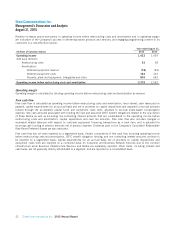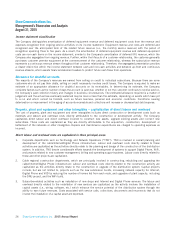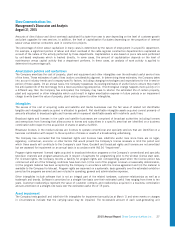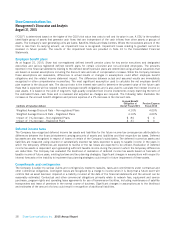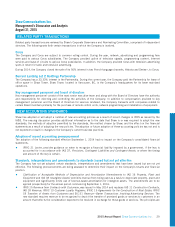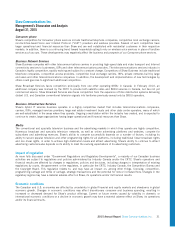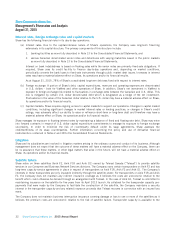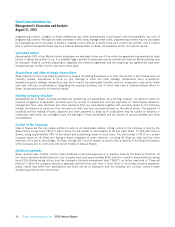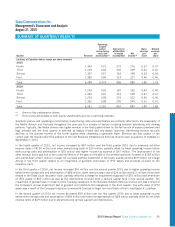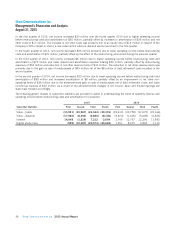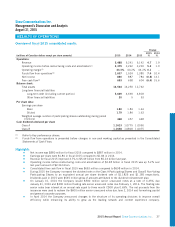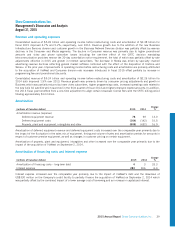Shaw 2015 Annual Report Download - page 34
Download and view the complete annual report
Please find page 34 of the 2015 Shaw annual report below. You can navigate through the pages in the report by either clicking on the pages listed below, or by using the keyword search tool below to find specific information within the annual report.Shaw Communications Inc.
Management’s Discussion and Analysis
August 31, 2015
Interest rates, foreign exchange rates and capital markets
Shaw has the following financial risks in its day-to-day operations:
(a) Interest rates: Due to the capital-intensive nature of Shaw’s operations, the Company uses long-term financing
extensively in its capital structure. The primary components of this structure include:
1. banking facilities as more fully described in Note 13 to the Consolidated Financial Statements, and
2. various Canadian denominated senior notes and debentures with varying maturities issued in the public markets
as more fully described in Note 13 to the Consolidated Financial Statements.
Interest on bank indebtedness is based on floating rates while the senior notes are primarily fixed-rate obligations. If
required, Shaw uses its credit facility to finance day-to-day operations and, depending on market conditions,
periodically converts the bank loans to fixed-rate instruments through public market debt issues. Increases in interest
rates may have a material adverse effect on Shaw, its operations and/or its financial results.
As at August 31, 2015, 78% of Shaw’s consolidated long-term debt was fixed with respect to interest rates.
(b) Foreign exchange: A portion of Shaw’s debt, capital expenditures, revenues and operating expenses are denominated
in U.S. dollars – both for ViaWest and other operations of Shaw. In addition, Shaw’s net investment in ViaWest is
exposed to foreign exchange risk related to fluctuations in exchange rates between the Canadian and U.S. dollar. This
risk is mitigated by certain U.S. dollar denominated debt which is designated as a hedge of the net investment.
Fluctuations in the value of the Canadian dollar relative to the U.S. dollar may have a material adverse effect on Shaw,
its operations and/or its financial results.
(c) Capital markets: Shaw requires ongoing access to capital markets to support our operations. Changes in capital market
conditions, including significant changes in market interest rates or lending practices, or changes in Shaw’s credit
ratings, may adversely affect our ability to raise or refinance short-term or long-term debt and therefore may have a
material adverse effect on Shaw, its operations and/or its financial results.
Shaw manages its exposure to floating interest rates by maintaining a balance of fixed and floating rate debt. Shaw may enter
into forward contracts in respect of U.S. dollar capital expenditure commitments to manage its exposure to foreign exchange
uncertainty. In order to minimize the risk of counterparty default under its swap agreements, Shaw assesses the
creditworthiness of its swap counterparties. Further information concerning the policy and use of derivative financial
instruments is contained in Notes 2 and 28 to the Consolidated Financial Statements.
Litigation
Shaw and its subsidiaries are involved in litigation matters arising in the ordinary course and conduct of its business. Although
management does not expect that the outcome of these matters will have a material adverse effect on the Company, there can
be no assurance that these matters, or other legal matters that arise in the future, will not have a material adverse effect on
Shaw, its operations and/or its financial results.
Satellite failure
Shaw relies on three satellites (Anik F2, Anik F1R and Anik G1) owned by Telesat Canada (“Telesat”) to provide satellite
services in our Consumer and Business Network Services divisions. The Company owns certain transponders on Anik F2 and has
long-term capacity service agreements in place in respect of transponders on Anik F1R, Anik F2 and Anik G1. The Company’s
interests in these transponders are only insurable indirectly through the satellite owner. For transponders on Anik F1R and Anik
F2, the Company does not maintain any indirect insurance coverage as it believes the costs are uneconomic relative to the
benefit which could otherwise be derived through an arrangement with Telesat. In the case of Anik G1, Telesat is committed to
maintaining insurance on the satellite for five years from its April 2013 launch. As collateral for the transponder capacity pre-
payments that were made by the Company to facilitate the construction of the satellite, the Company maintains a security
interest in the transponder capacity and any related insurance proceeds that Telesat recovers in connection with an insured loss
event.
The Company does not maintain business interruption insurance covering damage or loss to one or more of the satellites as it
believes the premium costs are uneconomic relative to the risk of satellite failure. Transponder capacity is available to the
32 Shaw Communications Inc. 2015 Annual Report


